

The majority of information and photographs in this Fact File have been provided by Paul Gorter, to whom I extend grateful thanks for helping me to finally get to grips with the Van Wouw Company story.
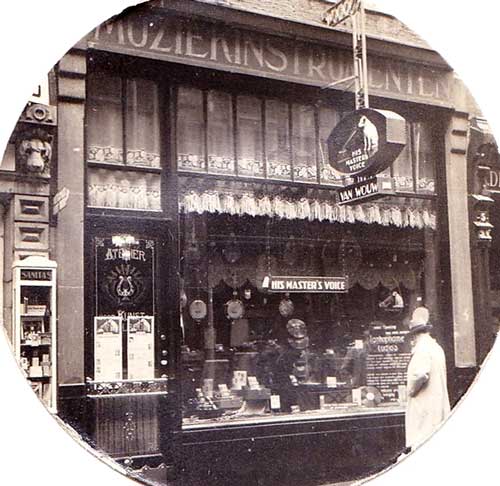
The Van Wouw Shop at the Heiligeweg, Amsterdam c1928
The Van Wouw Company based in Amsterdam were Hofner's sole importer and distributor in The Netherlands between the mid-1950's and the late-1970's or early 1980's.During the period up to around 1963 when the Beatles popularity began to stimulate other markets, they were one of Hofner's best customers for the Violin Bass and Club-Style guitars. That was due to the popularity of those particular models with the Indo-rock bands in The Netherlands, prior to the arrival of Fender solid and bass models in that country.
Mr Ludolf van Wouw was born in 1891 and in the 1920's he founded a shop at the Heiligeweg in Amsterdam selling musical instruments. By 1930, the shop was also selling record players, and records. As well as selling commercially-made records, the shop had a small recording studio attached. In the early 1930's, a Mr Marc Gorter (born 1906) left his job with the NSF Radio Factory (later to become Philips) and started working for Mr Van Wouw at the shop. Marc Gorter was a keen radio amateur who, as well as having worked for NSF, also made up radios at home for re-sale. In 1934, Ludolf Van Wouw and Marc Gorter went into partnership and set up a professional sound recording and film studio at Heerengracht 582, Amsterdam in parallel with the Heiligeweg shop. Marc Gorter lived, together with his family, in an apartment above the studio.
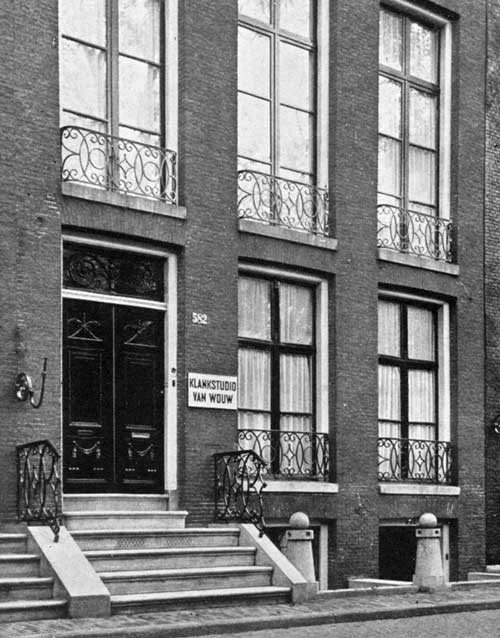
The Klankstudio Van Wouw at Heerengracht 582, Amsterdam in 1934.
This business went under the name of Klank en Filmstudio Van Wouw, and they were soon producing both private and commercial films, documentaries, and sound recordings. The business must have been successful because in 1937 the Company moved into larger premises at 15-17 Molenpad, Amsterdam. This building was a former school which had been built in 1884 and was now rented out by the city education authority. Van Wouw took over most of the ground floor, plus one classroom on the first floor which they used as a storeroom. A sculptor occupied another classroom on the first floor!
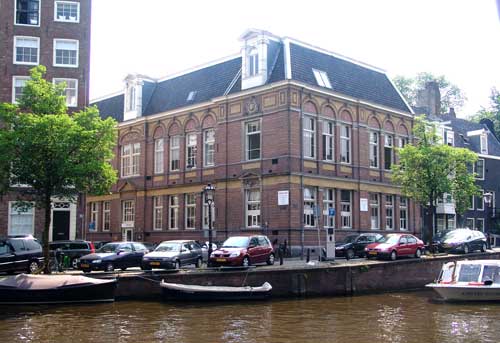
Location of the now defunct Van Wouw Company's business premises at 15-17 Molenpad, Amsterdam.
With the onset of World War Two and the occupation of The Netherlands by Germany, normal business was no longer possible. The Company's filming vehicle were requisitioned by the German Occupation authorities for their use, hence significantly reducing the company's capabilities. However, towards the end of the war, the Van Wouw Company managed to return to dealing with musical instruments, strings, and sheet music which laid the foundations for the future course of the Company.
After the war, radio receiving equipment was very scarce in The Netherlands as such sets had all been confiscated from the population during the German occupation. The major manufacturers in the country such as Philips could not initially satisfy the demand for radios. Using Marc Gorter's expertise gained before he joined up with Ludolf Van Wouw, the two partners decided to import high quality radio sets and gramophones from the Paillard Company in Switzerland. This lucrative business was pursued for a few years after which the Dutch manufacturers had caught up with demand and were able to supply cheaper items. The Van Wouw Company therefore moved further into the importation of musical instruments from other European countries.
Many different manufacturer's products were distributed by Van Wouw during the 1950's and 60's, including East German and Czech-made guitars. These were actually given the "Triumph" brand-name; a name that was also adopted by the Selmer London Company for their range of imported guitars. Other brands included Watkins/WEM amplification from the UK, Meazzi products from Italy, and National Supro guitars made by Valco in the United States. A major line of business for the company was good quality classical guitars which were shipped to Van Wouw from Spain, including the Telesforo Julve brand. As well as guitar-related items, Van Wouw also imported German-made wind instruments such as Kohlert and Orff percussion instruments for use in schools. Even Italian accordions, as well as electronic organs formed part of their inventory at one period.
Van Wouw probably started importing Hofner guitars into The Netherlands in the mid-1950's. The two photographs below are of the Van Wouw showroom, and were taken in August 1961. The first shows Marc Gorter examining a Hofner 125 Club-style guitar, and the second is of a fine collection of "Toaster" pickup-equipped Hofner guitars, overseen by Mr Vroons who was in charge of the Van Wouw workshops.
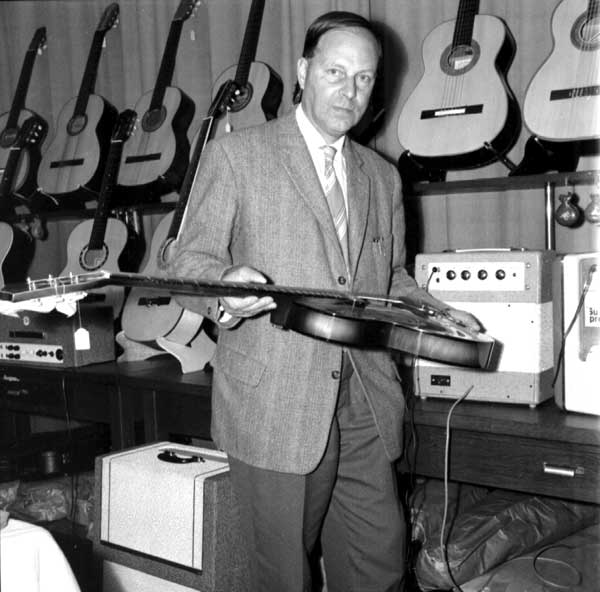
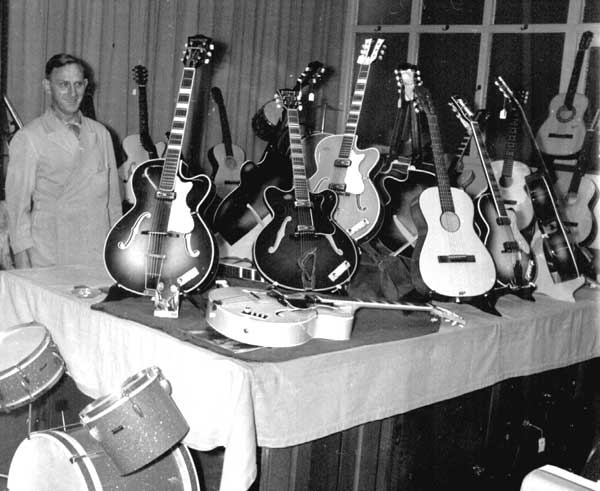
The newspaper photograph below shows Marc Gorter being shown a Hofner 191 Doubleneck at the Frankfurt Trade Show of 1961 by Walter Höfner. Visiting trade shows in order to assess the latest offerings by the various manufacturers, and the placement of orders for the year ahead, was an important duty in the calendar of the musical instrument importer.
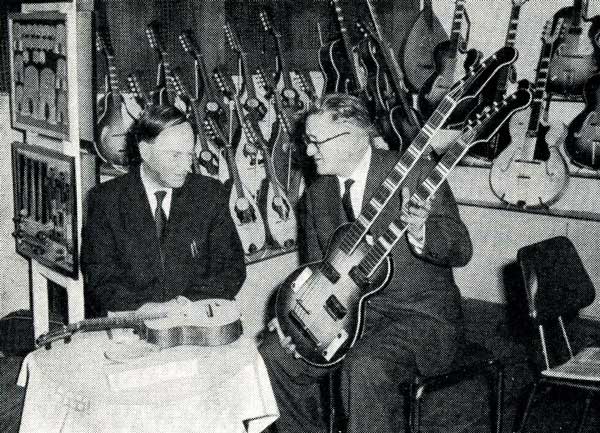
The most important customers, such as the Van Wouw Company, would be invited to visit the Hofner workshops at Bubenreuth in order to help them assess the quality of manufacture. These invitations tended to be also extended to the wives of the customer's principal, and the couple would be entertained by the whole Höfner family, including Wanda Höfner, who was Walter Höfner's wife. The photograph below shows Mr and Mrs Van Wouw together with Walter, Josef, and Wanda Höfner posing outside the Bubenreuth workshop.
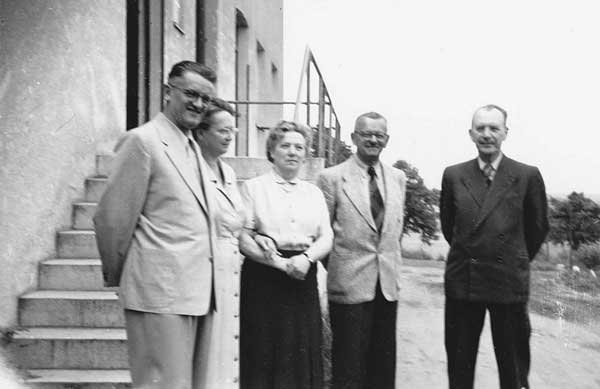
L. to R. : Walter Höfner, Wanda Höfner, Mrs Van Wouw, Josef Höfner, Mr Van Wouw.
Hofner guitars in The Netherlands developed a very enthusiastic following amongst the Indo-Rock bands who were dominant on the Dutch music scene in the late 1950's and early 1960's. Of particular interest to these bands were the Hofner "Club-style" electric guitars, such as the 125,126, and 128 models, as well as the Violin Bass. Solid-bodied instruments such as the Hofner 164, 173, and 176 models are also commonly to be seen in old photos of these bands. All these instruments were supplied by Van Wouw to such bands as the Blue Diamonds, the Black Dynamites, the Crazy Rockers, and many others.
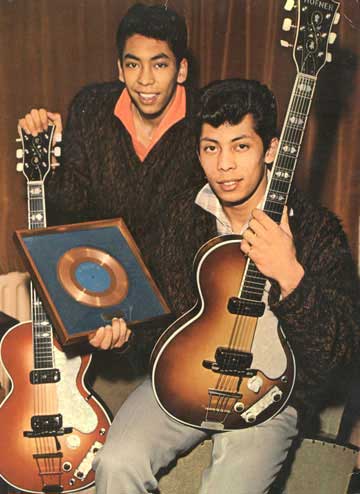
The Blue Diamonds with their gold disc for a million sales of "Ramona" and their Hofner 128 Club-style guitars fitted with optional (but rare) factory active electrics.
Time and fashion moved on however, with even the Indo-Rockers moving away from their trusty Hofners to Fender guitars in particular. During the late 1960's, sales generally subsided in the music trade, retailers started to import instruments direct from the USA and Japan themselves, and Van Wouw like a lot of other music instrument importers began to feel the pinch. They continued to act as Hofner's distributor for the Netherlands of course, but things were never the same as they had been in the boom days of 1958 to 1963.
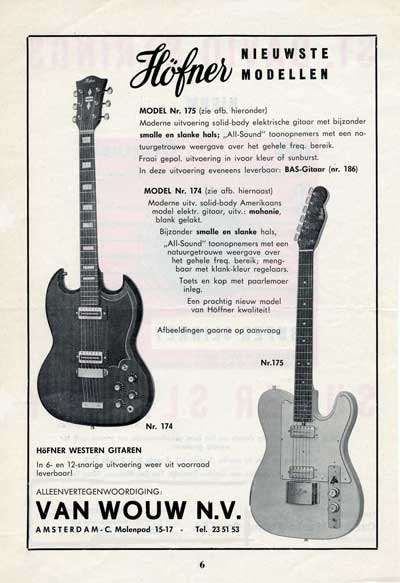
Van Wouw/Hofner Advertisement from 1970.
Ludolph van Wouw died in 1966, and Marc Gorter continued running the business until he retired in the early 1970's. His successor Mr Verwoerd continued the association with the Hofner Company, but finally the Van Wouw Company ceased trading in 1983, after around 50 years in the music, recording, film, wholesale radio, and musical instrument businesses.
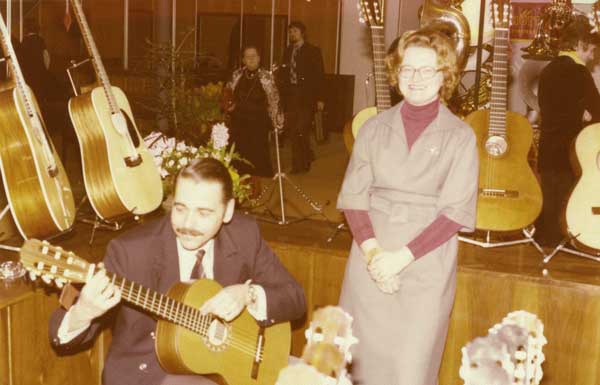
Mr Verwoerd of the Van Wouw Company tries out a Hofner 4981 model classical guitar at the 1976 Frankfurt Trade Show, with
Gerhilde Benker (née Höfner) in attendance.
Van Wouw applied their own serial numbers to the guitars that they imported in the Netherlands. These were applied in their own workshops by stamping numerals using a die into the top edge of the guitar's headstock. It would appear that a different numbering system was used for each manufacturer's products, as the Spanish-made instruments have numbers that do not correspond with Van Wouw Hofners of the same period. However, separate numbering systems were not adopted for each model, as was the case with the London-based Selmer Company.
No official records of the Van Wouw system that was used on Hofner's now exist. However, the following table may provide an approximate indication of dates relating to a few sample serial numbers.
| Approx Year |
Sample Serial Nos |
| 1960 | 1921; 2116; 2224; 2531. |
| 1961 | 3204; 3215; 3267; 3351; 3596; 3894; 3959; 4072. |
| 1962 | 4506; 4748; 5253; 5284; 5390; 5486. |
| 1964 | 7095. |
| 1965 | 7598. |
| 1966 | 8573. |
FURTHER HELP ON VAN WOUW SERIAL NUMBERS:
Harry Sibum of the HOFNER HOUSE WEBSITE also maintains a register of Van Wouw Serial Numbers. He can be contacted at hhm.sibum@ziggo.nl or through his website.